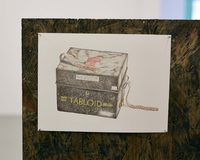Items
Site
The Medicine Chest
keywords is exactly
Glasgow
-

The Landis Museum
A drawing by the artist-curator James Hutchinson (Chapter Thirteen) based on an audio description of the object as art of the Glasgow International Arts festival. "Nina Liebenberg also undertakes a form of object analysis at an institutional border. She spent an afternoon in the strongroom of the University of Cape Town's special collections department, examining an early 20th century medicine box commissioned for a hunting trip in (then) Northern Rhodesia. Such boxes had been essential parts of the British colonial project, and allowed emigres, missionaries and explorers to venture deeper into unknown territory without fear of contracting tropical diseases. Liebenberg’s report from the strongroom acts as a set of instructions for The Landis Museum’s curator to make a drawing of the box, to which he has no physical access". Extract from the 'Exhibition Guide' of the Landis Museum (Chapter Thirteen), Glasgow International Arts Festival, 20 April - 07 May 2018. -

Silver Particle / Bronze (After Henry Moore).
"In Simon Starling’s work, inanimate objects are activated in various ways, especially when their political or economic history is revealed or when their materiality becomes an embodiment of something discovered during his research. His work enables and celebrates diverse interpretations of objects in many instances, as Greenblatt (1991) notes when referring to artistic and curatorial activity, deflecting attention away from the object onto the systems that gave rise to it in the first place. Starling conducts a close inspection of his objects, usually following a web of connections across the globe and across history, which in many of his works lead him back to the starting point; a vintage photograph of a Henry Moore sculpture leads to the production of a bronze sculpture based on the shape of a single enlarged silver particle that makes up the photograph and which, when converted into a sculpture, resembles the biomorphic shapes that served as inspiration for the Moore sculpture in the original vintage photograph ('Silver particle/bronze (after Henry Moore)', 2008). The machinations of its history somehow lost in the image when seen in the museum archive come back into play through the translations and reconstructions encountered in the detour and are materialised in the exhibition format" (Liebenberg 2021: 26 - 28). -

'How Zoology was taught in the past'
The wall text accompanying these charts in the Hunterian museum, Glasgow, reads: "In the late 19th and 20th centuries, before the advent of colour slides that could be projected, the teaching of Zoology depended heavily on the use of wall charts to illustrate lectures. They were hung on a special pulley system at the front of the lecture theatre and, because of their large size, could be clearly seen from the back of the class".


